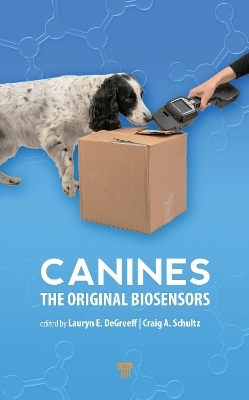
Canines
Jenny Stanford Publishing (Verlag)
978-981-4968-04-1 (ISBN)
Detection canines have been utilized throughout the world for over a century, and while numerous attempts have been made to replicate the canine’s ability to detect substances by mechanical means, none has been as successful. The olfactory system is a highly intricate and sophisticated design for chemical sensing, and the olfactory capacity of many animals, including canines, is considered unmatched by machine due to not only their great sensitivity and superior selectivity but also their trainability and mobility. These unique features have led to the use of such animals as "whole-animal" biosensors.
Amplifying the benefits and diminishing the limitations of detection canines' interdisciplinary research is crucial to understanding canine olfaction and detection and enhancing this powerful and complex detector. The past 50 years have produced vast advancements in animal behavior/training technology to develop canines into more proficient and reliable sensors, while scientific research has provided tremendous support to help practitioners better understand how to utilize this powerful sensor. This book assembles a diverse group of authors with expertise in a variety of fields relating to detection canines and the chemical sensing industry, including both research and operational perspectives on detection canines. It illustrates how science enhances our understanding of how canines are employed for solving some of the world’s leading detection challenges.
Lauryn E. DeGreeff earned her PhD in forensic chemistry from Florida International University (FIU), USA, where she is presently a professor in the Chemistry Department and the International Forensic Science Research Institute. Prior to returning to FIU, she conducted her research as part of the Chemistry Division at the US Naval Research Laboratory in Washington DC. Dr. DeGreeff takes a chemistry-based approach to studying olfaction for the purpose of informing field vapor sampling practices. Her research focuses on trace vapor sampling, characterization, and generation in support of canine and other field detection approaches. Dr. DeGreeff regularly lectures on the dynamics of odor for the operational community. Craig A. Schultz has 30 years of experience in animal behavior with organizations such as Disney’s Animal Kingdom, Palm Beach Zoo, Jacksonville Zoo, the United States Department of Agriculture’s National Detector Dog Training Center, and the Federal Bureau of Investigation. He has been a guest lecturer at several universities in addition to presenting at exotic animal, veterinary behavior, and working dog national conferences. He has also served as an active member of the Scientific Working Group on Dog and Orthogonal Detector Guidelines (SWGDOG) and the National Institute for Standards and Technology’s Organization of Scientific Area Committee (OSAC) Dogs and Sensors Subcommittee.
Section 1: A Dog’s World: Chemical Sensing through Olfaction 1. Introduction: Canine, the Original Biosensor 2. Comparing the Olfactory Capabilities of Dogs with Machines Designed to Detect Odors 3. Sensitivity and Selectivity in Canine Detectors 4. Chemical Information in Olfactory and Sensor Array Systems 5. Insect Olfaction in Chemical Sensing Section 2: Understanding the Canine Biosensor: Fundamentals 6. Neurobiological, Cognitive, and Behavioral Bases of Canine Olfactory Capabilities in Detection 7. Understanding the Dynamics of Odor to Aid in Odor Detection 8. Towards the Development of a Human Scent Model 9. How Science Supports and Law Influences Forensic Canine Utilization in the United States: Considerations for Human Scent Evidence (Trailing) and Human Remains Detection Canines Section 3: Fostering an Effective Sensor: Training and Evaluation 10. Training the Sensor: Impacts of Learning on Canine Detection and Performance 11. Training Considerations for Operational Performance: Train the Handler, Train the Dog, Train the Team 12. When Does Handler Perception Become Canine Detection? How Applied Behavior Analysis and Ethology Can Improve Handler Interpretation of Canine Behavior 13. Considerations for Testing the Capability of Operational Detection Dogs 14. Considerations in Vapor Generation and Delivery for Canine Testing and Training Section 4: The Canine Biosensor in Practice 15. Dogs as Detectors for Hidden Digital Storage Devices: A Pilot Study from the National Police of The Netherlands 16. The Use of Dogs for the Detection of Human Remains 17. Canine Detection of Blood Evidence 18. Using Trained Dogs in Rape and Assault Cases 19. Role of Dogs in Detection of Human Diseases 20. Canine Detection Teams to Support Oil Spill Response Surveys 21. Broader Perspectives: Case Studies of Detection Canines in the Field
| Erscheinungsdatum | 01.02.2022 |
|---|---|
| Zusatzinfo | 36 Tables, black and white; 9 Line drawings, color; 45 Line drawings, black and white; 2 Halftones, color; 53 Halftones, black and white; 11 Illustrations, color; 98 Illustrations, black and white |
| Sprache | englisch |
| Maße | 152 x 229 mm |
| Gewicht | 1760 g |
| Themenwelt | Schulbuch / Wörterbuch |
| Naturwissenschaften ► Biologie ► Zoologie | |
| Naturwissenschaften ► Chemie ► Analytische Chemie | |
| Weitere Fachgebiete ► Land- / Forstwirtschaft / Fischerei | |
| ISBN-10 | 981-4968-04-8 / 9814968048 |
| ISBN-13 | 978-981-4968-04-1 / 9789814968041 |
| Zustand | Neuware |
| Haben Sie eine Frage zum Produkt? |
aus dem Bereich


